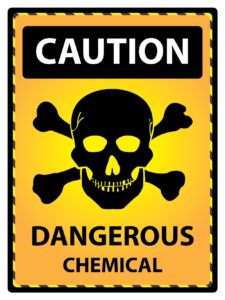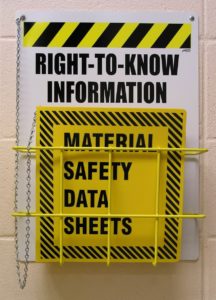Understanding Hazardous Chemical Material Safety Data Sheets Can Save You from Injury
 For many workers, handling hazardous chemicals is part of their daily routine. However, no matter how routine, you should never let your guard down when it comes to handling chemicals properly. Each chemical has its own set of hazards, which means the recommended emergency procedures for each chemical are different. If you are going to handle chemicals safely, you should be aware of the manufacturer’s recommended handling and storage procedures, the personal protective equipment you will need when handling, and the actions to take in the event of a chemical spill or leak.
For many workers, handling hazardous chemicals is part of their daily routine. However, no matter how routine, you should never let your guard down when it comes to handling chemicals properly. Each chemical has its own set of hazards, which means the recommended emergency procedures for each chemical are different. If you are going to handle chemicals safely, you should be aware of the manufacturer’s recommended handling and storage procedures, the personal protective equipment you will need when handling, and the actions to take in the event of a chemical spill or leak.
You can find this information on the “Material Safety Data Sheet” (MSDS), which must be sent from the manufacturer/supplier along with the chemical. OSHA requires all chemical manufacturers/suppliers to provide customers with MSDS’s that answer the questions listed above. However, OSHA does not require that MSDS’s be written in a standard format and most are written in technical language, which can be difficult to understand.

Realizing the need for standardization, The American National Standards Institute (ANSI) and the Chemical Manufacturers Association developed a standard format for MSDS’s. While its use is voluntary, many chemical manufacturers/suppliers have already adopted this format. The information provided by this format is broken down into the following sections:
Section 1 lists the manufacturer’s name, address and telephone number, the product name, the generic names for the chemical, the commonly used industry name and possibly, an emergency telephone number.
Section 2 provides information on the chemical’s ingredients. OSHA requires that all hazardous components be listed on the MSDS. Non-hazardous ingredients are usually included too if helpful in determining how to use and store the chemical.
Section 3 identifies the hazards of the material. This section is divided into two sub-sections. The first sub-section provides an overview and the second sub-section discusses the potential health effects of the chemical.
Section 4 describes basic first aid procedures to be used by a worker with no specific training in first aid. Instructions are provided for each type of potential exposure.
Sections 5 and 6 provide information, precautions and instructions to fight fires caused by the material, including hazards the material presents when burned and what methods can be used to extinguish flames.
Section 7 addresses risk prevention when working with the material, including proper storage procedures.
Section 8 discusses controls and protective equipment.
Section 9 describes the physical and chemical properties of the material.
Section 10 contains information on stability and reactivity of the chemical including whether the chemical has the potential to react with another substance due to oxidation, heat, decomposition or polymerization.
Sections 11 through 13 outline toxological and ecological information, including how to dispose of the chemical.
Sections 14 through 16 explain methods to transport the chemical.
Material Safety Data Sheets are important tools when working with hazardous chemicals. Of course, a tool is only effective if you understand how to use it. Be sure you know where the MSDS’s are kept for the chemicals you use and familiarize yourself with them. And most importantly, know where you can find the emergency information on all of the MSDS’s for chemicals in your work area.
Huff Insurance is a full service Independent Insurance Agent We have been dedicated to Protecting Lifestyles™ since 1960. We offer a full array of Personal Insurance, Commercial Insurance and Life Insurance & Health Insurance products. Call us at 410-647-111

